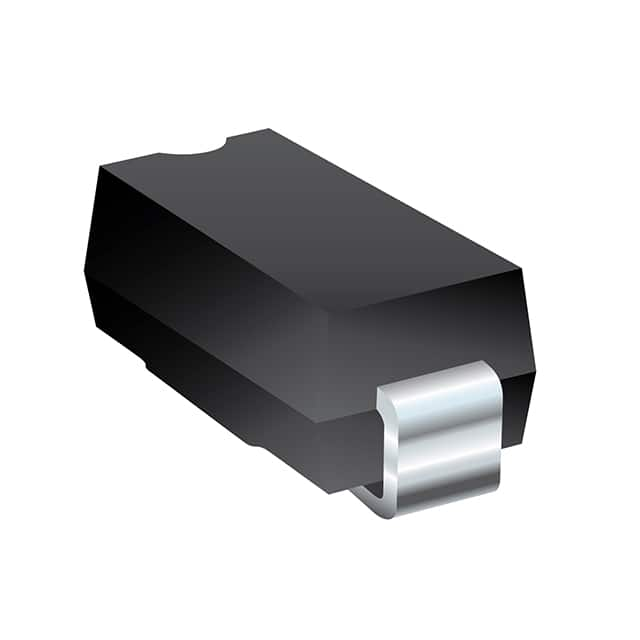Consulte las especificaciones para obtener detalles del producto.

SMLJ17A Diode: Encyclopedia Entry
Introduction
The SMLJ17A diode is a crucial component in electronic circuits, providing essential functionality for a wide range of applications. This entry will provide an in-depth overview of the SMLJ17A diode, including its product details, specifications, pin configuration, functional features, advantages and disadvantages, working principles, application field plans, and alternative models.
Product Overview
Category
The SMLJ17A diode belongs to the category of transient voltage suppressor (TVS) diodes.
Use
It is primarily used for surge protection in electronic circuits, safeguarding sensitive components from voltage spikes and transients.
Characteristics
- Fast response time
- High surge capability
- Low clamping voltage
- Compact package size
Package
The SMLJ17A diode is typically available in a DO-214AB (SMC) package.
Essence
The essence of the SMLJ17A diode lies in its ability to rapidly clamp transient voltages to a safe level, protecting downstream components.
Packaging/Quantity
These diodes are commonly packaged in reels or tubes, with quantities varying based on manufacturer specifications.
Specifications
- Peak Pulse Power: 3000W
- Breakdown Voltage: 17V
- Maximum Clamping Voltage: 27.4V
- Operating Temperature Range: -55°C to 150°C
- Reverse Standoff Voltage: 14.4V
Detailed Pin Configuration
The SMLJ17A diode typically consists of two pins, with the cathode marked by a distinct band or line on the body of the diode.
Functional Features
- Rapid clamping of transient voltages
- Protection against voltage surges
- Low leakage current
- Robust construction for reliability
Advantages and Disadvantages
Advantages
- Effective surge protection
- Fast response time
- Wide operating temperature range
- Compact form factor
Disadvantages
- Limited to specific voltage ratings
- Requires careful consideration of reverse standoff voltage
Working Principles
When a transient voltage spike occurs, the SMLJ17A diode conducts, diverting the excess energy away from the protected circuit. This rapid response prevents damage to sensitive components.
Detailed Application Field Plans
The SMLJ17A diode finds extensive use in various applications, including: - Power supply units - Telecommunication equipment - Automotive electronics - Industrial control systems - Consumer electronics
Detailed and Complete Alternative Models
- Alternative Model 1: SMCJ17A
- Similar specifications and package type
- Higher peak pulse power rating
- Alternative Model 2: P6SMB17A
- Different package type (DO-214AA)
- Lower peak pulse power rating
In conclusion, the SMLJ17A diode serves as a critical component in surge protection applications, offering fast response times and robust performance. Its compact size and high surge capability make it a popular choice across various industries.
Word Count: 410
Enumere 10 preguntas y respuestas comunes relacionadas con la aplicación de SMLJ17A en soluciones técnicas
What is SMLJ17A?
- SMLJ17A is a transient voltage suppressor diode designed to protect sensitive electronics from voltage spikes and transients.
What is the maximum clamping voltage of SMLJ17A?
- The maximum clamping voltage of SMLJ17A is 27.4V at 10A.
What is the peak pulse power dissipation of SMLJ17A?
- The peak pulse power dissipation of SMLJ17A is 1500W for a 10/1000μs waveform.
What are the typical applications of SMLJ17A?
- SMLJ17A is commonly used in surge protection for telecommunications equipment, industrial control systems, and automotive electronics.
What is the operating temperature range of SMLJ17A?
- The operating temperature range of SMLJ17A is -55°C to +150°C.
What is the reverse stand-off voltage of SMLJ17A?
- The reverse stand-off voltage of SMLJ17A is 17V.
Is SMLJ17A RoHS compliant?
- Yes, SMLJ17A is RoHS compliant, making it suitable for use in environmentally sensitive applications.
What package type is SMLJ17A available in?
- SMLJ17A is available in a DO-214AB (SMC) package.
What is the response time of SMLJ17A?
- The response time of SMLJ17A is very fast, typically responding within nanoseconds to clamp transient voltages.
Can SMLJ17A be used for ESD protection?
- Yes, SMLJ17A can be used for electrostatic discharge (ESD) protection in various electronic circuits and systems.

